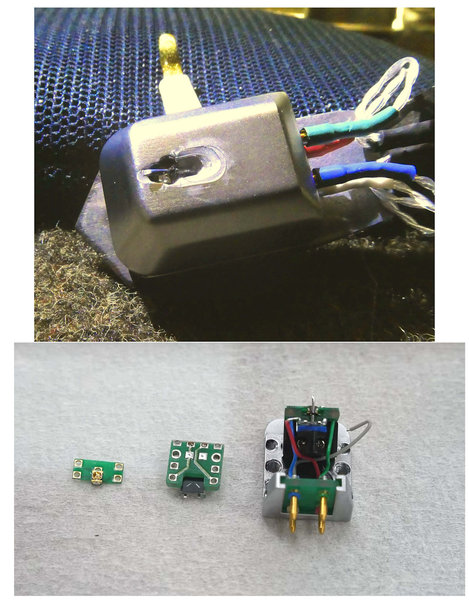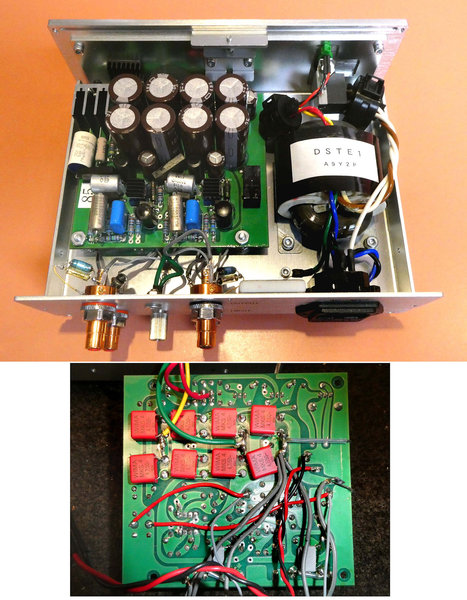|
What can I say? I was a diehard moving-coil cartridge user until DS Audio came along. After I auditioned a set-up at a friend's house I was sold.
I went with the E1 system since it was based on an IC op-amp rather than any of the single-ended transistor models (002, 003, W2, W3, and Master models) with aluminum electrolytic output-coupling caps.
I modified my DS Audio E1 equalizer a while back and I took a chance because even with careful selection of parts for this project there was no way to predict the outcome. Was it worth the money and effort? YES! As it turned out it was well worth the time and effort.
I had ideas about further improvement but the stock RCA jacks were not removable because of soldered connections to the threaded fitting – that made access to the PC board almost impossible without labeling and desoldering the connections as well as compromising access to the areas of interest on the PC board. So rather than screw up my first effort I obtained another E1 equalizer and pretty much performed a complete rebuild. Cutting out those cheap RCAs was the first and worst part of the project.
Replacement of critical path parts in order to upgrade the overall performance of the equalizer involved the use of Teflon and stacked-film polycarbonate capacitors, and Vishay bulk film and Vishay Angstrohm glass hermetic resistors. Power supply capacitors were bypassed with 4.7-ufd WIMA pulse capacitors. Direct PVC signal-path wiring was replaced with silver/copper Teflon wiring. The E1 had a switch for 50-Hz. roll-off and 30-Hz. roll-off that was connected with PVC wiring through the switch to short out the coupling cap providing the high-pass function for 50-Hz. I had no use for the 50-Hz. roll-off so I dumped the audio-compromising switch and associated PVC wiring and replaced it with a ½-inch dead short.
The JRC 072B J-FET op-amps used in the stock E1 are much better than anyone gives them credit for and were designed for high-quality audio playback. However, I installed DIP sockets in place of the op-amps so I could “roll” op-amps like rolling tubes. My first op-amp trial has turned out to be the charm – military grade dual FET-input OPA2604-Q1 op-amps (ceramic). These Burr Brown beauties were designed for professional audio equipment, PCM DAC I/V convertors, and spectral analysis equipment.
Also, to enable long-term reliability, heat sinks were installed on the op-amps and I added heat sinks to the power supply regulators. Constrained layer damping enhanced the case work to limit acoustic breakthrough along with a sand-filled power line fuse – plus I added two RFI/EMI ferrite filters to the power supply.
I also modified the E1 cartridge as well. That work involved applying a polymer resin to the cantilever and inserting acoustic fill inside the cartridge-body hollow cavity to suppress subtle roughness that could be attributed to the cantilever or other issues with the cartridge construction.
This exercise proved that we haven't heard what the DS Audio optical cartridge is capable of until now. My first E1 mod got close – my second – I believe achieved that goal. A marvel of engineering held back by essentially those damn equalizers that had everything to do with the passive and active parts utilized in the design of the equalizer. Keep in mind -- that the passive parts in the E1 are the exact same parts used in the entire DS Audio product line save for the op-amps used exclusively in the DC-coupled E1. In terms of overall audio quality and overall musicality, the passive parts DS Audio is using in their products, as far as I am concerned, only achieve an acceptable level of mediocrity (ALM). I found it interesting how much a negative impact DS Audio’s choice of resistors had on the sound much less those inexpensive film capacitors. And of course -- the new Burr Brown chip paid unexpected dividends.
Improved transparency was only part of the audition observations with the upgraded E1. Playback issues that could be easily blamed on the recordings were reduced dramatically with special notice given to Columbia Records that never quite provided a less than "brittle" playback quality. The overall musicality was much improved with a “grain less” transparency that I didn't possible with any device tracking LPs whether MC, MI, MM, or even the DS Audio optical cartridges.
My final observation? WOW!
| Attachments: |

E1 Cartridge Upgraded.jpg [ 317.69 KiB | Viewed 47887 times ]
|

DS Audio DIY Image 2.jpg [ 500.66 KiB | Viewed 47887 times ]
|

DS Audio DIY Image 1.jpg [ 279.21 KiB | Viewed 47887 times ]
|
_________________
Walt
|



